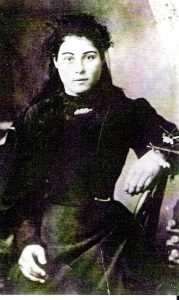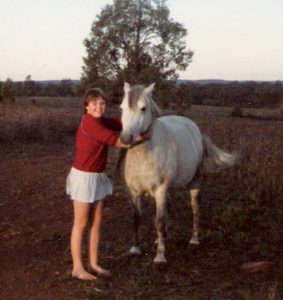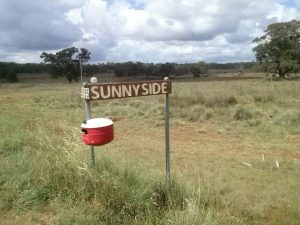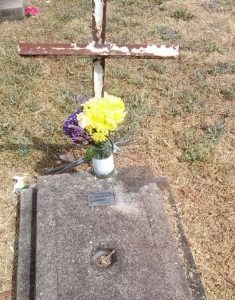14 minute read
This week’s Sunday Storytelling blog is a tribute to my favourite ancestor, my paternal 2 x great grandmother, Ellen Broadie. Am I allowed to say favourite ancestor? I probably shouldn’t! But it’s hard not to have favourites when you have such a remarkable ancestor as Ellen. Ellen was one of the first ancestors I ‘met’; introduced to me by my paternal grandmother Irene. Irene never got to meet Ellen, her own maternal grandmother, as Ellen died five years before she was born. Irene learnt about Ellen from the woman who joined them together, her mother Minnie. Minnie was just 18 years old when Ellen died, but she kept Ellen’s memory alive by telling Irene stories about her and safely keeping one precious photograph of her. When I became interested in family history during my early teen years, Ellen’s photo was probably the first one my grandmother pulled out to show me. I have therefore known Ellen the longest and yet she is the one I long to know more about. There are some facts about Ellen’s life that have been handed down to me, but in putting together a timeline and doing a little bit of research, I’ve come to know Ellen on a deeper level in the past couple of weeks. Creating a timeline is a great way to find gaps in a story that can be plugged to present a more rounded history of a person. Because for a long time, I saw Ellen as a tragic figure, as a woman whose life was ended prematurely by childbirth. Indeed, in entitling this piece ‘The price of love is grief’, I run the risk of re-enforcing that image. This was a phrase I heard recently upon the death of a former work colleague and I feel it is rather fitting for Ellen and for the family she left behind. For she was, in the words of Minnie, ‘a wonderful mother.’ She was adored by her husband and her children and was gone from their lives far too soon. The price of their love, was indeed grief, at the loss of such a beautiful individual. But if we look further and examine more than just her death, the facts bring to light a woman who was not only a wonderful mother, but a selfless woman, a brave woman and a capable woman. This is Ellen’s story.

Ellen May Core was the fifth child and fourth-born daughter of James Core and Mary Ann Snook who had married in 1870. Ellen was born on the 9th July 1879 in Forbes. Her father was a rather resourceful man who moved around NSW working variously as a gold miner, hawker, publican and labourer. Her mother Mary Ann birthed twelve of her own children and then helped to deliver her own grandchildren as the years went by. Sadly, Ellen’s young life was marred by the tragic deaths of some of her siblings. When she was two years old, her baby sister Maria died. In Ellen’s fifth year, her toddler sister Isabella died. And when she was nine years old, Ellen’s 15-year-old sister Sarah caught a disease which inflamed her brain and bowel and ultimately proved fatal. The family moved around a bit but eventually put down some roots in the Dubbo area for a while. In 1892, James Core took up running a pub at Dandaloo, near Trangie. Called the Halfway House, it attracted all sorts of characters, including a smooth-talking William Edward O’Brien, who sought out some business ventures with James. Ensconcing himself within the family, Edward took such a shine to eldest daughter Mary Ann that he married her. It was not long however that he was found out to be a liar and a cheat, when money he promised James did not appear. However, another wife did appear! William O’Brien was sent to gaol in Dubbo and his marriage to Mary Ann was annulled. Seeing a stranger take advantage of her sister may have influenced Ellen when it came to her own choice of husband.
Ellen was in her late teens when her family moved back to where her father’s side of the family, the Cores, lived in the Wattle Flat and Sofala area, just north of Bathurst. The first record of the family living in the area is sadly a newspaper report of the death of her younger brother William. Riding his horse home one day and encouraging it to do some dangerous tricks, the horse fell and crushed him. William was only 15 years old and Ellen just 18. It would have been a devastating blow for the whole family and a reminder for Ellen of just how precarious life was, particularly since Ellen spent a lot of time on horseback. It was also here in Wattle Flat however, that Ellen became acquainted with her second cousin, George Broadie, who was three years her senior. Ellen was working as a domestic servant and George, having been brought up by his grandparents all his life, had followed in his grandfather George Lawson’s footsteps by working as a gold digger. George and Ellen were married in May 1899, and at their wedding, Ellen was already a few months’ pregnant. Having birthed a dozen of her own children, Ellen’s mother Mary Ann helped deliver baby Clara, who was born prematurely in September.
George kept his new family well enough on the money he earnt from gold mining but it meant going where he could find work. The family left Wattle Flat around 1902 and moved firstly to Rylstone and then to Upper Pyramul, near Mudgee. From 1899 to 1913, Ellen would give birth to ten children or on average, one every 16 months. There were six daughters, Clara (called Minnie due to her prematurity), Mary, May, Vera, Ada and Emily. The boys were called Joseph, Russell, Claude and William. In describing Ellen as a wonderful mother, Minnie told how Ellen would bake her own bread and make her own butter to feed her family. She also made the children’s clothes.
It is here, in the telling of stories of Ellen from my grandmother, that I was immediately drawn to her, when I found out that she was an accomplished horsewoman who competed in shows. Growing up I became a little obsessed with horses and I started riding lessons when I was about 9 or 10. Every Saturday for a year or so, I rocked up for a riding lesson where I learnt to wrangle (what appeared to a child to be) very large horses; trotting, cantering, jumping over logs and even a dip in the river, riding bareback. I’ve never been so scared but exhilarated at the same time. I got thrown off at least twice that I remember. One day my horse Mango decided he needed a feed of grass, so I let him eat for a while. Big mistake! The rest of the riding party left to go back to the house and when Mango looked up and saw they had left, he immediately decided to join them, by bolting as fast as he could home. I only just managed to hang on for dear life. It may have been after this I said ‘OK enough, this is not for me!’ I had my own horse for a few years, a grey gelding called Johnny, who was blind in one eye. But he spooked easily so I hardly ever rode him; he just enjoyed hanging out with the cows and sheep on our farm. I’ve clearly never been as brave as Ellen was.

I do not know for sure if Ellen rode in these shows before she married or after, or both. She did not live in the Mudgee area until the late 1890s, just a few years before she married. During her marriage she also lived close enough to Mudgee to compete there, however her near-constant state of pregnancy may have prevented her from entering competitions. Despite extensive searches on Trove, I’ve been unable to find a mention of Ellen in relation to her competition in horse shows. However, the Mudgee Guardian of May 1899, the same month Ellen got married, carried a story about the local show. ‘The quartette of ladies figuring for the guinea (money) prize, best rider, were certainly nice to look at as they cantered, trotted, etc.’ The young girls did not miss out either. ‘Pony jumping was a bit exciting. There is always a real live time in store when the Australian girls take to piloting the horse over the hurdles.’ What is even more remarkable to me is that Ellen did all her riding side-saddle, as was the custom for the ladies at the time. And in a long skirt! An article entitled ‘The Side-Saddle Controversy’, widely published in 1890, warned of the dangers of allowing women to ride ‘astride’ using a man’s saddle. ‘It is the opinion of the expert that the roundness of a woman’s limbs and her general build absolutely incapacitate her from riding with safety in a man’s saddle.’ The article concluded that the side saddle was much safer as it had only one stirrup that a lady’s foot could get caught in!
Another family story handed down relates the tale of heroism on Ellen’s part. There are no specific details on where and when this occurred and I have again scoured the newspapers for signs of this event to no avail. It is said that during a big flood, Ellen rode her horse through the floodwaters to rescue a child; a child that turned out to be a child of a local policeman. I wish I knew how this unfolded and how she came to be in the vicinity when the child was swept into the water. Did she receive some kind of accolade afterwards? Clearly it was a significant event for it to be handed down through the generations. It speaks of her selflessness and utter bravery in face of danger. The other mystery, yet to be confirmed, is of Ellen’s brush with the bushranger Jimmy Governor. The story goes that Ellen and her eldest daughter Minnie (a baby at the time) were travelling in a stagecoach when he approached and demanded money. Again, this is the only thing we know. I have looked for an article describing the hold-up but none has so far been found. The story of Jimmy Governor is one which is famous in Australian folklore and if you have not read the book or seen the movie, please take the opportunity to do so. His story is still relevant today, particularly in relation to the Black Lives Matter movement. Jimmy spent some months on the run from the law and criss-crossed back and forth the area where Ellen lived in 1900. I have traced Jimmy’s movements through newspaper accounts and he definitely was in the area where Ellen lived, so it is entirely possible the story is true. I always try to confirm family legends and have been able to do so in many cases, but for Ellen’s stories, so far the stamp of truth remains elusive.
By 1912, when baby Claude, the ninth child arrived, the family was living in Pyramul. When he was six months old, Claude came down with a disease that caused gastro-enteritis. Six days of convulsions followed. A trip to Mudgee Hospital could not save him. Claude was buried in Pyramul cemetery the day after his sister Minnie’s 13th birthday. Having left school at age 11 to help her mother care for the family, it was Minnie’s first real loss and one she would never forget. Sometime after this, George and Ellen moved their large brood of children to Binnaway and to a working farm called ‘Sunnyside.’ George may have been employed by the owners or they may have just lived in a house on the property. What we also know of Ellen’s life with George highlights a marriage of love and shared passions for similar things. They loved being a part of the Binnaway community and every Sunday, George and Ellen would attend church with their children. George would play the button accordion and Ellen, who was said to have a lovely voice, would sing for the congregation. Their life together was a simple one but one filled with love. Ellen also made good use of her riding skills, as it has been said that she was the one who rode her horse, day or night, to fetch the doctor when the children were ill. This could mean a few miles there and back, in the dark, a round trip that could take an hour or more.

By 1917 Ellen’s eldest girls were getting married and starting families of their own, but Ellen herself was as yet only 38 years old and so it was that she became pregnant with her eleventh child. Bearing so many children in the space of just eighteen years may have started to take a heavy toll on her body. Family legend also handed down says that Ellen may have suffered from epilepsy; if this is the case she was a truly remarkable woman to have managed so many children whilst potentially suffering fits herself. In October 1917, Ellen began labouring to deliver her latest baby. But something went wrong this time and Ellen started haemorrhaging. She suffered cardiac failure as a result of the blood loss and died, her baby boy also dying with her. It must have been a terrible shock to George and the children, most of whom were old enough to understand what was happening. Her youngest was just four years old and another three of the children were aged under ten. George was heartbroken but with the help of the older children and his married daughters, he took on the role of caring for them as best he could. George felt Ellen’s loss so greatly that he never remarried. I visited Ellen’s grave for the first time in 2015 and I also found the property ‘Sunnyside’ that they lived on. Her grave is adorned with a simple painted white cross.

Whilst I know so much about Ellen, there is still more I would love to know. Sadly, it is more than likely lost to history. Still, it is wonderful to be able to connect with a woman who, whilst seemingly many generations from me, is also actually closely connected. My grandmother Irene is the connector; for Ellen was Irene’s grandmother and the same number of generations separates me from Irene. We may both never have known Ellen personally, but she is remembered and honoured within our family and I hope this little story goes a bit further to helping bridge that connection with her other descendants. Ellen was a truly remarkable woman, whose strength, courage and bravery will continue to inspire future generations.
This story is dedicated to Ellen’s descendants who share her love of horses and are accomplished horsewomen in their own right; Emily, Ellen’s 3 x great granddaughter; Karen and Alicia, Ellen’s 2 and 3 x great granddaughters. May they continue to ride and compete in the same spirit of their ancestor Ellen for many years to come.
